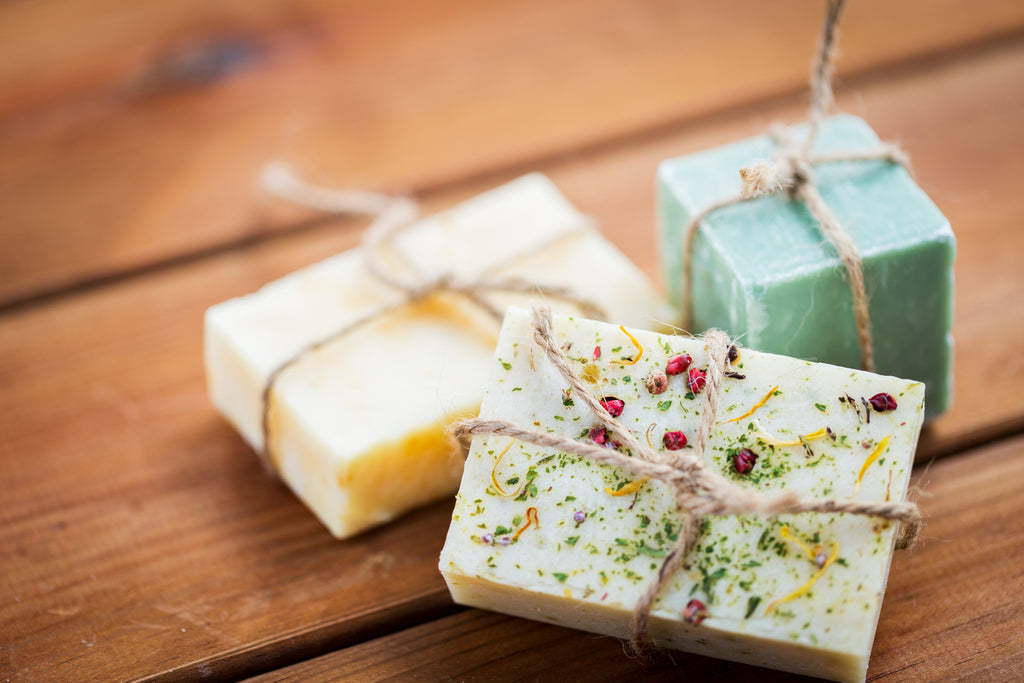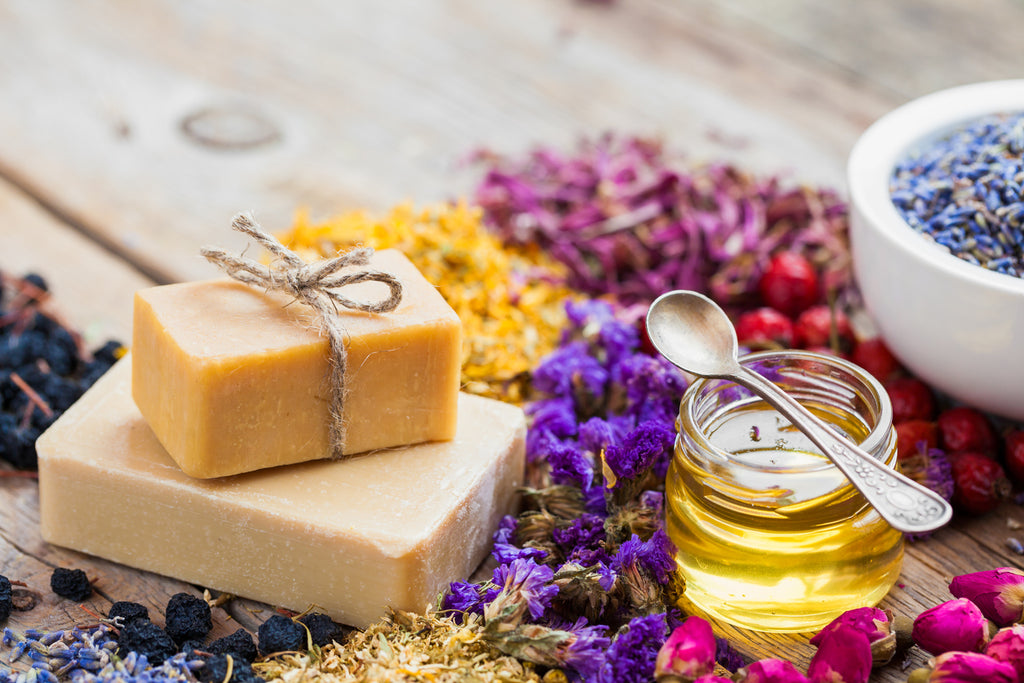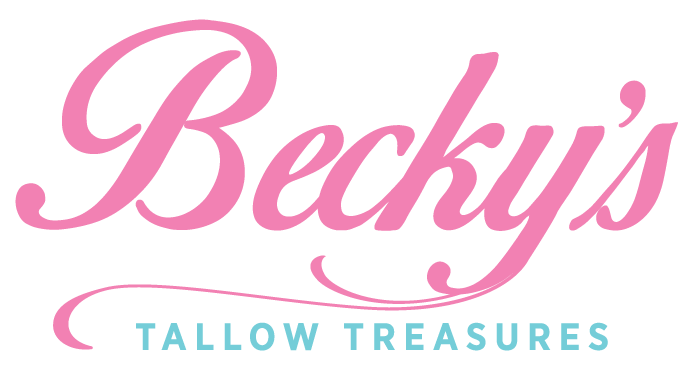
Why is genuine, authentic, real soap – created via the mixing of fats or oils with an alkali base – almost always preferable to a glycerin melt-and-pour style soap? To explore this question, we'll first learn a bit about saponification: the long and fancy word used to describe the primary chemical reaction of soap making. Along the way, we'll dispel some common myths and misunderstandings, and provide all the information that you'll need to make your own intelligent choices.
Saponification: The Alchemy Of Soap-Making
As mentioned above, the primary chemical reaction involved in the making of real soap is known as "saponification." This comes from the root word "sapo" -- which is Latin for "soap." So saponification literally means "turning into soap."
Saponification is an exothermic reaction (meaning that it gives off heat) that happens when fats or oils (i.e. fatty acids) come into contact with the alkali base of lye. Once the lye and the fats/oils have been mixed and the raw soap has been poured into the mold, the saponification process typically takes 24-48 hours to complete.
In simple terms, the saponification process can be represented via this equation:
Fats/oils + lye (dispersed into water) = soap + glycerin
Looking closely at this equation can help us to dispel two common myths:
1. The first myth is that traditionally-made soap does not include glycerin. The truth is that since glycerin is a natural byproduct of this chemical reaction, all true soap is glycerin soap!
2. The second myth is that traditionally-made soap has lye as one of its ingredients. The truth is that while lye is used to catalyze the chemical reaction required to produce the soap, it is transformed completely in this process – so that the soap itself contains absolutely no lye!
The Magic Of Chemical Transmutation
The formal chemical name for lye is sodium hydroxide, whose shorthand notation is: NaOH. In the saponification process used to create Becky's Tallow Soap, for instance, the Na (sodium) reacts with the tallow (beef fat) to produce sodium tallowate (the tallow soap), with glycerin as a byproduct. And the OH (hydroxide) bonds with another H (hydrogen atom) to produce H2O (water).
So once again, the bottom line here is that the final bar of soap – i.e. the product of this chemical reaction -- contains no lye whatsoever.
The situation is a bit analogous to that of table salt – a common culinary ingredient which (when used in moderation) is perfectly safe for human consumption. But Sodium Chloride (NaCl) – the chemical name for table salt -- is created via the combination of chlorine (Cl) – a poisonous gas – and sodium (Na) – a toxic metal. Even though its two constituents are non-edible, the final product – table salt – is not only perfectly safe but also provides the human body with essential nutrients.
And so it is with the use of lye in the alchemy of soap-making: authentic soap, like common table salt, is perfectly safe – so don't be misled by those who would tell you otherwise.

The Low-Down On Melt-And-Pour Glycerin "Soaps"
Now that we've cleared up two common myths, and understand that authentic soap is 100% lye-free, and naturally contains glycerin; let's learn a bit more about melt-and-pour style glycerin soaps.
As its name implies, a melt-and-pour style soap is made by melting down a block of base material – and then pouring the melted material into smaller soap molds. Between the initial melting and final pouring, a host of other ingredients can be added: dyes for color; fragrances for scent; dried herbs; and all variety of small glittery objects to give the soap a crafty or artistic feel.
Soap v. Detergent
Sometimes the base material of a melt-and-pour glycerin soap contains real soap (created via the saponification process) -- though more frequently these kinds of "soaps" are made mostly of detergent. So what's the difference between soap and detergent?
True soap is made with natural fats and oils (e.g. tallow, coconut oil, olive oil, or palm oil) -- while detergents are synthetic and typically petroleum-based. Most so-called "glycerin soap" is made from a base of detergents, with added preservatives, synthetic fragrances, and artificial dyes. Occasionally you may find a "glycerin soap" base that is true soap; however, there will almost inevitably be chemicals (such as sorbitol and propylene glycol) added to make it possible for such a soap to melt and re-form again.
Makers of melt-and-pour glycerin soaps will sometimes advertise them as being "made without any lye." As it turns out, however, this is a completely hollow claim, for the following reasons:
1. As we've already learned, authentic soap – in its final form – also is completely free from lye.
2. A glycerin soap that contains no authentic (saponified) soap will almost invariably have loads of artificial chemicals.
3. If the base material of the melt-and-pour glycerin soap does indeed include authentic (saponified) soap –- the secondary producers can still claim that their own soaps are made without lye – because the saponification process (using lye) doesn't happen at their own factories. This is kind of like using a boxed cake mix to bake a cake – and then claiming that you yourself "did not use any flour" to make the cake, because the flour didn't come from your own kitchen, but rather from the box that you purchased at the grocery store.
Customizing Your Authentic Soap
What makes the soaps at Becky's Tallow Treasures different from other soaps is the use of organic grass-fed tallow, organic ingredients, and therapeutic essential oils. Also, our ability to customize a facial, bath, or shampoo soap for you goes beyond simply letting you choose your favorite essential oils. In addition, we can customize the soap base itself – creating a mix of oils and/or tallow that perfectly suits your needs. Do you simply adore coconut oil? If so, we can use that in your soap base. Are you allergic to coconut oil? No problem! – we can avoid using this oil in your soap base.
By making our soaps in the traditional way, we can guarantee a perfect consistency (not-too-hard, and not-too-melty) – along with the highest quality natural and organic ingredients. We delight in creating soap products that are genuinely therapeutic and a delight to use.
We look forward to serving you!




When my cryptocurrency wallet was suddenly emptied, leaving me with a loss of $417,000, I was engulfed in shock and disbelief. It felt as if the ground had been ripped out from under me. The severity of the situation was overwhelming, but the emotional impact was even more profound when I discovered the identity of the perpetrator. It turned out to be my ex-girlfriend, who had been unfaithful and deceitful. The betrayal stung with an intensity I hadn’t anticipated. To have someone I once trusted so deeply and intimately turn against me in such a devastating way left me feeling utterly crushed.My immediate reaction was a whirlwind of anger, sadness, and confusion. I struggled to come to terms with the dual blow of losing a significant amount of money and dealing with the emotional fallout of being betrayed by someone I had loved and trusted. It seemed like a nightmare I couldn’t wake up from. My focus shifted to finding a way to recover the lost funds. Desperation drove me to explore every possible avenue for recourse. In my search for solutions, I came across various recovery services and read countless forums for advice. Among these, I stumbled upon a recommendation for Hacker Judas on Reddit. The post was a detailed account of how they had helped someone recover their stolen cryptocurrency. The story was compelling and seemed promising, offering a glimmer of hope amidst the chaos I was experiencing. Hacker Judas had numerous positive testimonials and a track record that reassured me they were reputable. I decided to reach out to them, explaining my situation in detail and providing all necessary information related to the theft. The process of working with them was thorough; they conducted an initial assessment, and their team seemed genuinely invested in helping me recover the stolen assets. The recovery process was meticulous and took several weeks, but Hacker Judas kept me updated throughout. Their expertise and persistence were evident, and gradually, the hope of retrieving my funds began to feel more tangible. While the emotional and financial impacts of the theft were still challenging to cope with, knowing that I had taken steps towards recovery provided some solace.Hacker Judas was able to recover a portion of my lost cryptocurrency. Although not everything was retrieved, the recovery of a significant part was a relief and helped restore some of my faith in the process. The experience was a harsh lesson in trust and vulnerability, but it also highlighted the importance of seeking professional help when faced with such dire circumstances.
https://hackerjudasrecovery.info .. email: hackerjudas 9 @g mail . com